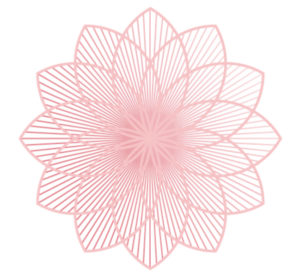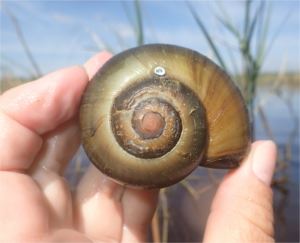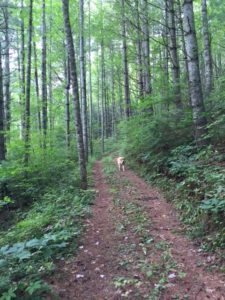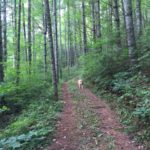Dream symbols are the essential message carriers from the instinctive to the rational parts of the human mind, and their interpretation enriches the poverty of consciousness so that it learns to understand again the forgotten language of the instincts. ~Carl Jung, Man and His Symbols
I’m too committed to my psychological and spiritual growth to cling to assumptions that have no practical value for me. If believing in the connectedness of all life and the meaning in all things did not produce observable healthy change, I would accommodate myself to what did; but the fact is that mythos, the symbolic way of thinking that is sister to masculine logos–the focused and organized thinking preferred by the ego and the left hemisphere of the brain–has served me exceedingly well in my efforts to become more conscious, whole, and connected.
Mythos is the language of the body, heart, and soul. It is associated with the right hemisphere of the brain and the feminine realm—i.e., all that is mysterious, unconscious, creative, felt, organic, and personally compelling. It whispers to us in feelings, physical symptoms, imagination, fantasy, stories, myths, and dreams that reveal unconscious dimensions of ourselves.
 Both logos and mythos contribute to our fullest development. Children use mythos thinking automatically. This is why they respond to everything new with spontaneity, enthusiasm, joy and wonder. But once the masculine phase of external striving sets in, literal, rational thinking tends to dominate our thinking and life begins to lose its savor. Those who never leave mythos behind or who return to it later on discover undeveloped aspects of themselves by following fascinating symbols, powerful emotions, cognitive dissonance, uncomfortable personal dilemmas, and bodily symptoms through the labyrinthine maze of the unconscious.
Both logos and mythos contribute to our fullest development. Children use mythos thinking automatically. This is why they respond to everything new with spontaneity, enthusiasm, joy and wonder. But once the masculine phase of external striving sets in, literal, rational thinking tends to dominate our thinking and life begins to lose its savor. Those who never leave mythos behind or who return to it later on discover undeveloped aspects of themselves by following fascinating symbols, powerful emotions, cognitive dissonance, uncomfortable personal dilemmas, and bodily symptoms through the labyrinthine maze of the unconscious.
Symbols are the language of the unconscious. They hint at things that are inexpressible. When we notice and wonder about them they unlock doors to hidden chambers of ourselves wherein we discover purpose and meaning. Some symbols only have special meaning for certain individuals or groups; others have universal appeal. Take, for example, a dot and a circle. Why does every culture on the planet use these simple designs in religion, art, architecture, literature, and adornment? Is this just an amazing coincidence, or is there something profound within each of us to which they speak?
 In A Dictionary of Symbols, J.E. Cirlot tells us that a dot is a symbol of unity and the Origin. A circle suggests infinity, the All. And a circle with a dot or hole in the center represents the center of infinity, i.e., emanation or first cause. These symbols all speak to the same psychic reality, the Self which contains our predisposition to believe in a sacred realm, shapes our images and ideas about it, and motivates our spiritual search.
In A Dictionary of Symbols, J.E. Cirlot tells us that a dot is a symbol of unity and the Origin. A circle suggests infinity, the All. And a circle with a dot or hole in the center represents the center of infinity, i.e., emanation or first cause. These symbols all speak to the same psychic reality, the Self which contains our predisposition to believe in a sacred realm, shapes our images and ideas about it, and motivates our spiritual search.
We cannot know our Source of Being—the eternal essence that we call God, Goddess, Father, Mother, Jahweh, Allah, Great Spirit, or whatever term you prefer—and words alone can never describe all that we intuit. But the universal symbols of the dot and the circle resonate with all of us.
Eastern religions have produced myriad renderings of circular mandalas, each with a center point, upon which devotees may focus their thoughts during meditation. Similarly, native peoples throughout the Western world have long created sacred circles in sand paintings and arrangements of stones as aids to worship in religious ceremonies. Jung saw mandalas as symbols of individuation, and his The Red Book contains many of the exquisite images he painted during his most intense time of inner exploration.
 These and other symbols—geometric shapes, abstract designs, art depictions of people engaged in certain universal activities, animals, plants, shells, imaginary beings or objects—capture our attention with mysterious power because they carry important meaning for us.
These and other symbols—geometric shapes, abstract designs, art depictions of people engaged in certain universal activities, animals, plants, shells, imaginary beings or objects—capture our attention with mysterious power because they carry important meaning for us.
What symbols and activities inspired your childhood imagination and appeared in your fantasies? Do they still appeal to you today? What do they say about your passions and journey through life? How can you bring them into your life to create more meaning and fulfillment?
Paper and E-book versions of The Bridge to Wholeness and Dream Theatres of the Soul are at Amazon. The Wilbur Award-winning Healing the Sacred Divide can be found at Amazon and Larson Publications.com. Jean’s new Nautilus Award-winning The Soul’s Twins, is at Amazon and Schiffer’s Red Feather Mind, Body, Spirit. Subscribe to her newsletter at www.jeanbenedictraffa.com.






40 Responses
Dear Jean,
I love your blog and the contemplative spirit with which it is written. I notice you describe the unconscious as a labyrinth, and in the context imply it to be a place of confusion. I am a labyrinth lover – I facilitate groups with walking meditation and I am in the process of raising the funds to build Sydney’s first major public labyrinth. To me, a labyrinth is a path of peace and truth – a well of the Divine Feminine at which we may drink deep and nourish our souls. The concept of “maze” might have suited your purpose better in this instance. Sorry to nitpick, but these two words have been overlapped for too long…
With thanks and best wishes for all you do.
Emily
Hi Emily,
Thank you for the warm words. I’m so glad you enjoy my blog. Thanks also for your clarification that a labyrinth and a maze are not quite the same thing. For example, the Cretan labyrinth that contained the Minotaur had many intricate mazes in it, whereas many others do not.
Coincidentally, I too am a labyrinth lover and was instrumental in the fund-raising, purchasing, and painting of a large canvas labyrinth for indoor use in Central Florida! Ours is a replica of the one in Chartres Cathedral, and we’ve used it in some wonderful settings with many groups. I share your associations with the symbol. I also see it as a metaphor for the journey through the unconscious, which is not always completely pleasant and often feared, but ultimately enormously affirming and empowering.
For me it is relevant in this post because it is a circle with a center point which I see as the Self. I love the fact that our labyrinth sometimes takes the walker very close to the center and sometimes to the very outer edges before you actually reach the center. This is exactly how I’ve experienced my inner journey, which has never been a clear and direct line from point A to point B! While I do occasionally manage to touch and even briefly inhabit the central holy space of the Self, mostly I circumambulate around it!
The fact that you and I have some different associations for this symbol is a lovely example of how the same symbol can have different shades of meaning for different individuals depending on their personal experiences and subjective realities. This is exactly as it should be. In fact, it is the essential value of the mythos mode of thinking: it validates the worth of each of us, no matter who or where we are, in a way that is meant to promote our individual journeys to the Sacred.
Thank you for writing!
My very best to you,
Jeanie
I have known about mandalas for a long time, being once a member of a Hindu-cult, but I could never understand why I draw so many dots. Whenever I doodle, I’m likely to make a flower and a dot, or a leaf and a dot, a feather and a dot, a heart and a dot… you get the point 🙂 It was great reading the article and finding out it was my way of trying to connect with the Origin, the Source. This makes so much sense, and helpes me in my own path. Thank you once again!
HI Argenta,
Yes, I got the point, and enjoyed a good laugh over it! I’m so glad you found this post helpful!
You’re very welcome, and thank you for commenting.
My very best,
Jeanie
Spirals. Always spirals.
Ahh, yes. I love spirals too! Did you know that some scholars relate their meaning to labyrinths? Both illustrate cyclic development, the movement of involution and evolution in the cosmos, return and renewal, etc. I always see this as a very positive symbol pointing to the universal truth that spring’s new growth always follows winter, and summer’s blossoming always follows spring!
Sending you much love,
Jeanie
Reply
Jean, I am so happy you commented on my blog the other day, as I’d lost track of your blog here, and am having a wonderful time re/discovering everything you have written. A very rich personal and collective exploration….
Best, will be back again soon,
Ka
KA, I’m so glad you found my comment meaningful. It was a great dream!! And I love your blog. Your photographs are gorgeous.
Thanks for rediscovering and liking my blog. It looks like we’re on the same path, each using our unique gifts to express and interpret it in our individual ways!
My best to you,
Jeanie
P.S. I know a lot of people don’t want to clutter up their mail boxes with lots of incoming mail, but if you want to receive my blog posts via e-mail as I do yours, you can subscribe at the above right of this page, just beneath my picture. WordPress doesn’t ask for any information other than your e-mail address and it doesn’t share this information with anyone else. J
Yes, I just changed the wordpress notification / delivery setting so I’ll be reminded more regularly. A little more feminine-Jungian thought in my inbox can only be a good thing…. 🙂
Jean,
After reading this I decided to spend some time this morning writing down the meaningful symbols in my life from my childhood right up through to my present and the symbols that now surround me.The tapestry of symbols woven together over time have reflected who I am and what my life has thus far been about. Amazing. Thank you for another wonderful springboard for self reflection. By the way, the logo for MorningStar is a 4 pointed star/cross over a circle that connects the 4 intermediate points of the star to form a square with a circle within it and within that two pine trees and the morning star in the dawning sky above them. It’s been about women/the feminine finding direction in the dawn of a new day.
Gratefully, for your contribution toward this dawning, Julie
Hi Julie,
I’m so pleased to know this post triggered some meaningful inner work for you. I love the combination of symbols you used for your logo. And I love, love, love knowing I’ve made a contribution to the dawning of feminine guidance! Sending much appreciation to you today.
Jeanie
I spent time in India and was moved by a common daily practice. In the south, every morning, the women of a house, rich or poor, clean the walk in front of the house and create a chalk drawing (rangoli in sanskrit, or kolam in Tamil). From simple to complex motif, in both design and color, it is always a renewed welcome expressed in symbol. Not a bad way to start the day!
What a beautiful custom! It’s what I call “living your myth.” Rituals like this keep us connected to the Sacred in ways nothing else can do. Thank you for telling me about it! Jeanie
Dear Jeanie,
Thank you for this wonderful post! Mythos certainly feels like my first language as a poet and psychotherapist who loves symbolism and metaphor. My logos side, on the other hand, is much weaker I sense, and although I do recognise this imbalance, my heart and soul pulls me evermore towards mythos. It’s amazing that you’ve reposted this at Lammas, time of the First Harvest and abundance, when those first seeds of love, our metaphoric dots and circles, are harvested.
As a child spiral shapes of all kinds would pull me in, star shapes too but most of all I loved my old tin kaleidoscope. I would play with it for hours and hours, slowly turning it to create new exquisite designs. I was totally fascinated how just a barrel, mirrors and a few beads (yes I took mine apart!) could create such magick and mystery. Today I recognise these shapes as mandalas and see them everywhere in nature, spirals and stars too. Mandalas of joy I call them!
If you’re interested I wrote a new poem for Lammas titled “Love is the Seed” and posted it to my poetry and Jungian thought blog. It’ll be there for a few more days before it too gets harvested down to its first three lines. Without consciously realising it, I posted it on Jung’s birthday.
Love, light and Lammas blessings, Deborah
Dear Deborah,
First of all, thank you for letting me know about your new poem posted on https://theliberatedsheep.com. I loved it and have just finished commenting on it. I wish WordPress would send your posts to me again. I’ve missed getting notices. I’ve checked out your site but can’t find a way to re-subscribe. Can you install a widget that would make that possible?
I didn’t realize I’d posted this at Lammas. It’s not a celebration I’m familiar with, but I’ve checked it out and see that it’s about the first harvest of the year: the time when the first seeds (the Source of all life, (i.e. the dot and circle) come to fruition. What a marvelous synchronicity!
I love knowing that spirals, as seen through your childhood kaleidoscope, inspired your childhood and foretold the direction of your soul’s calling. For my readers, here’s what I just found about the symbolic meaning of a spiral: “It represents life, creation, birth and rebirth, evolution, awareness, and growth or development. The single spiral stands for the radiance of cosmic energy. It also symbolizes knowledge and perseverance, truly a perfect symbol for people who want to move forward.” Is that you or what?
From the age of 5, I’ve been profoundly attracted to horses. I didn’t know anything about symbolism then, or why I loved them so passionately, but I do know now. I dream about horses often…several times a year. Last week I dreamed about calming and rescuing a panicked white horse who was stuck in the middle of a busy road. In Jungian psychology the horse represents the fundamental power and energy of life. The dream says I want to help life. And it’s true. I do. That’s why I write. It was so affirming to receive this message from my unconscious Self.
Love, light, and Lammas blessings to you too, dear friend. Jeanie
You’re most welcome Jeanie and thank you so much for your beautiful, eloquent reply! Marvellous synchronicity indeed then that you posted this at Lammas. I saw the dot and circle connection immediately and assumed you’d timed this to perfection but now it’s even better to know that synchronicity was at play all along!
As much as I was drawn to spirals and stars as a child, it was my kaleidoscope that gifted me magickal mandalas and it was these shapes and designs that I loved best, still do. I mean I was deeply fascinated by them! Although many thanks for sharing the spiral’s symbolic meaning though, perseverance really stood out.
It’s amazing the different things we’re deeply drawn too as young children, it was horses for you while the sky, as a very young child, held deep fascination for me, especially the time, probably around five when I saw my first (remembered) rainbow, it looked like what was going on inside my kalidscope had become real!
As for WordPress, I’ve kind of replied on my blog but not entirely sure that my answer will help but you never know. Ah, I’ve just looked and noticed that the subscription widget that I did put up is no longer there, hmm, I’ll have a go at sorting it out tomorrow. Until then, bye for now.
Ah, yes, you did say that it was the mandalas with their exquisite shapes and designs that fascinated you the most as a child. And of course, mandalas symbolize the Self. That makes perfect sense. Sorry I missed that! Of course that’s you! Thanks for clarifying that for me. And both of us, despite the differences between our childhood symbols, were deeply drawn from an early age to exploring and aiding the inner life and becoming our true selves, with their many facets and designs. 🙂
Let me now if you manage to sort out the subscription widget. I can’t wait to get back on your list and feast on your nurturing posts on a regular basis!
Thank you for putting into words Jeanie a shared experience I can relate to deeply. Hmm, all this talk about “facets” and “designs” has given me an idea for a new poem! Yes, will let you know re WP widget.
Well, all thanks to our “facet” and “design” conversations and reminiscing on my old tin kaleidoscope yesterday, a new short poem, “The Mirror Ball of the Self” emerged this morning. I’ve just posted it on my blog. Many thanks dear Jeanie, I had no idea this one would come today. Love and light, Deborah.
Deborah, your self-awareness and openness to your muse never fails to amaze me! You are a walking, talking, writing image of creativity. I just read it and love it. Thank you for allowing me to be part of your process. Love, Jeanie
That’s so lovely of you to say, thank you so much Jeanie! Thank you again for the creative inspiration. Love Deborah.
Again, thank you.
Again, you’re most welcome. Thank you for letting me know you liked this. I’d love to know what it is about these recent posts that resonates. It would help me choose pertinent themes for future posts. With love, Jeanie
Aah. I bet I know. The mention of horse as a meaningful symbol since childhood. I suspect it was the same for you.
Actually it is about the divine femine. Everything you share offers a more detailed view. Thank you!
It is time for me tto buy the book.
Oh, thank you for letting me know this. I ordered and started your book last spring and loved what I read, but it’s not with me this summer so I can’t finish it! I will when I get it back. And if it’s sold on Amazon I’ll write a review for it.
I wonder which book you might want. I think you’d like all my books — they’re all about connecting with the Divine Feminine. The Bridge to Wholeness was the first. It’s a memoir about how I first began to connect with the Sacred Feminine in myself. Maybe starting with that one makes the most sense. Then if you like what you read you can try my second: Dream Theatres of the Soul: Empowering the Feminine through Jungian Dreamwork. It’s about some of my dreams (I started recording them at the age of 46) and how I worked with them to understand more about the Divine Feminine in myself. The third was Healing the Sacred Divine. It’s also about connecting with and uniting our feminine sides with our masculine sides in practical ways and includes many personal spiritual experiences. It’s directed to helping people understand how important it is to connect their inner feminine and masculine opposites. The Soul’s Twins (my most recent and a Nautilus Silver Medal award-winner) is about four pairs of feminine and masculine archetypes and how becoming aware of them and accepting them in ourselves is a sacred practice. I wrote these last two to help readers do their own inner work from two different perspectives.
Thank you so much for writing. I’ll see if I can post something with a focus on the divine feminine soon! 🙂 I wish you well on your journey to the divine feminine and wholeness.
Love and blessings, Jeanie
I am not good at following up on my communications. I started with your first book. Thank you for purchasing mine.
You’re most welcome! No worries. I guess I didn’t tell you I loved your book, either. Thank you for purchasing Bridge to Wholeness. I think you’ll especially like my references to horses!
Which book do your recommend next?
It’s so odd you would be writing me at this very moment. I’ve just been trying to post a comment about your latest post for the last 20 minutes on your site and it won’t let me. First it wanted me to sign in, then it wouldn’t accept my password, then it timed out, etc. So I came back here to see if I could respond to your last comment from here, and you’d just written this question!! Wow! First I’ll answer your question then I’ll tell you what I tried to say in my comment to your post.
My second book is Dream Theatres of the Soul: Empowering the Feminine through Jungian Dream Work. If you’re interested in learning more about the guidance you can get from your dreams, I’d suggest you try that one. (It’s quite spiritual in its own way.) But if dreams don’t interest you all that much, I’d suggest Healing the Sacred Divide. There are lots of personal stories in it, plus a whole lot else.
As for my comment to your latest post, I just wanted to say how touched I was by it. I’m so sorry you haven’t been able to ride for so long, and I’m so glad you found just the right people to get you back up there where you belong. There’s nothing like riding a horse. I miss it too. But I do get to hang out with horses at the stable where my granddaughter keeps her horses, and also at her shows. Heaven! Blessings and best wishes for you in the new year. Jeanie
Thank you Jean. Totally enthralled by the posts re women repression and the brain. Amazing.
Thank you. I’m so glad to know that women are appreciating this thread! I find it absolutely fascinating! Best, Jeanie
Thanks for this post, Jeanie. I felt the connection to Lammas (the seeds, harvest, and the round loaves of bread) and also the kolums in Tamil Nadu mentioned by WaterOverFire and Marion Woodman’s frequent reference to spirals. In a blog a few weeks ago, I wrote about a dream of Marion Woodman at the center of a circle of women and a few men and that was followed by a surprise call the following morning from the Jung Institute of Chicago asking to interview me about Marion Woodman. Wow! And then looking back at the first Marion books I read in 1988, I re-discovered what I’d long forgotten. The first chapter of ‘The Pregnant Virgin’ is named “Chrysalis” and tells the story of Marion’s 3 year old experience of death (the chrysalis) and rebirth (butterfly). A dream and 2 synchronicities, so lots of intuitive exploration ahead and a pause in writing my book about Monarchs because I need to include more of the sacred significance and don’t know how to proceed.
I have approximately 120 Monarch eggs, caterpillars, and chrysalises in my back porch nursery, a pleasurable mania about nurturing them and releasing butterflies into the world. My sons laugh and call me a butterfly hoarder. Today, 2 females will fly, eventually leaving their tiny round eggs of butterfly potential.on milkweed leaves where I find them, save them from predators by bringing them into the nursery, and the cycle begins again.
I was a mother-pleasing logos child and it’s taken me my adult life to integrate mythos. I’m grateful for the women in my mythology class which has met since 1990–with some change in participants, but many of the original group still participating and co-leading. We used to meet in a circle with an altar in the middle, but that’s all changed now that we meet on Zoom. I miss those sacred circles and I’m glad they appear in dreams. Thanks for stirring my imagination and blessings to you.
Wow, indeed, Elaine! Congratulations on your interview with the Jung Institute of Chicago. Look how your posts about your friendship with Marion and words of wisdom about the mysteries of life and death have spread, just like the Monarch eggs you mother. I remember that conversation we had at dinner so many years ago after Vic’s presentation to the Winter Park Jung Center. You told me then how proud you were of Vic’s work and you were struggling to find something to share with the world that was yours. You’ve certainly found that special something, haven’t you? Well done!
Your description of your childhood focus as a mother-pleasing logos child couldn’t describe me better. I was the same, although I not only wanted to please my mother, but protect her from any kind of psychological pain as well. In retrospect I see it was difficult burden for a young, fatherless girl. Perhaps you felt some of that too, although you had the courage to challenge her conventional control over you far earlier than I did.
I’ve had many wonderful women’s circles over the years. Some lasted about ten years, one lasted 20. They were all super supportive and enriching, but many are gone now. That phase of my life seems to be over, but I’m so grateful for all the insights I gained and lessons I learned.
Thank you for writing, Elaine. I’m glad our friendship has endured through all these years.
Love,
Jeanie
Thank you Jeanie for this lovely post. The first thought I had was about the Dao (Tao) symbol, with its black and white circle and in each the dot of the other. My painting still to be finished is of circles of different colours, with the Dao symbol in the middle. The top circle ends in the serpent. Many of my very naive paintings are of the circle. From childhood onwards that was mostly my doodling. Circles within circles, overlapping. An old one in my study is of a tree, red canvas with white dots. A lovely abstract is of circles floating – and a very old one is on a black circular background, with dots all around it, done with my left hand as my right hand was badly damaged at the time.
Your third graphic is one I doodle quite a bit. Also the infinity symbol ..
The Cry of Myth by Rollo May is a book I enjoyed many years ago which I’ve just pulled out of my bookshelf to re-read. I love that our late first democratically elected president of our country, Mr Nelson Mandela’s name is nearly a mandala.
The way I see it is that we’re being called now to live our myth … and to me this means that the divine feminine myth is being re-vitalised. In the words of Diane von Furstenburg. “now is the time to live your myth’.
I loved all the comments too! With love and gratitude, Susan
Dear Susan, thank you for sharing some of your meaningful symbols. It sounds like your soul has been expressing itself creatively in art since you were a chid. Perhaps that’s what all doodling and art is: the soul’s need to express itself. I’d love to see pictures of your art some day.
I ran across Rollo May in the 80’s but never read The Cry of Myth. I loved Jung’s Man and His Symbols though: “No genius has ever sat down with a pen or a brush in his [her] hand and said: “Now I am going to invent a symbol.” He had it right. Symbols come to us from the unconscious…all we do is find creative ways to express what comes to us instinctively.
I love your observation thatNelson Mandela’s name is nearly a mandala. I haven’t thought of it that way but have occasionally pronounced it that way without thinking! 🙂 Such a very apt name for such a highly individuated and evolved man.
I see living my myth in a similar way. In fact, I wrote my first book with the purpose of revitalizing the feminine within myself and sharing what I was learning. I suspect that was the idea you had in mind when you wrote your first book, In Praise of Lilith, Eve & the Serpent in the Garden of Eden & Other Stories. You were one of the early ones to address that growing need in writing. After my first book I gradually found myself compelled to write about uniting the feminine with the masculine in my inner life and outer life in an egalitarian partnership. I suspect that compulsion has something to do with my parents divorcing when I was only 11 years old. If my soul didn’t start out with that goal at birth, it soon came to pursue it, especially after my marriage. I’m still working on it!
Much love,
Jeanie
You have done such sterling work Jeanie in highlighting the need for the divine feminine. And not for dominance but for balance of the masculine and feminine energies. The need for this is becoming clearer for very many, as we’ve all been wounded and you write about this so profoundly, and in such an engaging way. Love and deep gratitude, Susan
Thank you.❤️